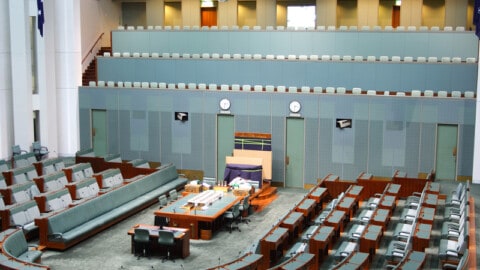As rooftop solar and batteries become the norm, how to appropriately manage their output becomes an increasing challenge around Australia. We spoke to Suleman Alli, Director of Strategy at UK Power Networks, ahead of his international keynote presentation at Digital Utilities 2020, about the utility’s plans to create the world’s most advanced electricity network control system and how it is maximising the opportunities presented by Distributed Energy Resources (DER).

Suleman Alli, Director of Strategy, UK Power Networks
With more than 2.1 million solar homes, Australia has the highest penetration of residential rooftop solar in the world.
The challenge with this strong solar uptake – along with the growing household battery storage and electric vehicle markets – is understanding how to best integrate the large amounts of small-scale solar generation into a grid that was never designed for two-way flows of power.
Many in the Australian energy industry are starting to look to new network management models – and taking inspiration from overseas.
The role of Distribution System Operator (DSO) is gaining traction in the UK and across Europe, and could have implications for the local sector.
Smart Power, a report from the UK National Infrastructure Commission following studies of the country’s electricity sector, identified that a DSO would undertake the conventional role of a distribution network owner, but would also make full use of smart techniques and the flexibility of DER to create value for the wider electricity system.
UK Power Networks, the company which keeps the lights on for more than 18 million customers in London and the south-east of England, was among the first electricity networks in the UK to launch a strategy setting out its transition from Distribution Network Operator (DNO) to DSO.
The utility has already commenced its journey to becoming a DSO, and Suleman Alli, Director of Strategy, is the man responsible for leading the transition.
“UK Power Networks is transitioning from the traditional role of a DNO, managing assets, to a DSO, managing outcomes and balancing an increasingly complex, interconnected and low-carbon electricity network,” Mr Alli said.
“We believe that the core objectives of UK Power Networks’ vision – keeping the lights on, providing great customer service and reducing customer costs – remain central to a successful DSO transition.
“However to succeed as a DSO, we are developing additional capabilities to deliver value for customers in the wider electricity system by enhancing network visibility, modelling and new control functions to enable whole system optimisation.
“As such, our ‘Future Smart’ DSO strategy and roadmap revolves around a five-point action plan that focuses on facilitating cheaper and faster connections using proven innovation, prioritising customer flexibility as an alternative to network upgrades, creating the world’s most advanced electricity network control system, collaborating with industry to enable nation-wide benefits, and preparing for and facilitating the uptake of Electric Vehicles (EVs).
“Starting from our Low Carbon London innovation project in 2010, we have continued to innovate, develop and deploy smart tools, techniques and technologies that unlock capabilities for the delivery of our DSO roadmap.
“One such example includes our world-leading innovation project, ‘Flexible Plug and Play’, to facilitate faster and cheaper distributed generation connections, which became a business-as-usual product, ‘Flexible Distributed Generation’.
Through this we have connected over 120MW of renewable generation, increasing the liquidity of the flexibility services market, and delivered savings of over £70 million for connecting customers.
“Flexible Plug and Play was the first project to explore the use of flexible connections through innovative commercial arrangements in Great Britain.
Flexible connections allow distributed generation customers to connect to the distribution network on the basis that their generation output can be controlled by the DNO whilst the network is kept within operational limits.
“In October 2019, we announced a new flexible connections product using our new active network management system. Customers will benefit from low-cost, fast connections to the network and access to a simple application process which can be found online.
An industry-leading online mapping tool has been developed to give customers a guide on potential curtailment zones.”
Mr Alli explained that through its experience of running flexibility tenders in 2017, UK Power Networks learned that market liquidity is fundamental to the success of its aspiration to use flexibility services as an alternative to network reinforcement.
“We also learned that it is essential to promote further transparency and accessibility of our data and requirements, whilst maintaining market neutrality.
As such, UK Power Networks collaborated with software company Piclo and signposted our constraint areas, heat maps and procurement process on their Piclo Flex platform to increase market liquidity and enable wider customer participation.”
Investing in innovation
At UK Power Networks, innovation is defined as the development and implementation of any approach which enables the utility to achieve its objectives more quickly, affordably, safely or to a higher standard, and which uses methods that are unconventional in the context of the business.
UK Power Networks has a dedicated team of 32 engineers, project managers and other specialists whose focus is to deliver an ever-growing portfolio of innovation projects.
The utility has deployed 30 innovative solutions into business-as-usual operations since the start of the RIIO-ED1 period in 2015, which has led to £182 million in savings.
The organisation is actively collaborating with over 100 project partners, and has access to over 7,000 small and medium enterprises through its membership with the Energy Innovation Centre.
The innovation portfolio is split into three key focus areas:
- Efficient and effective
- Low carbon ready
- Future ready
“The biggest challenge of innovation is embedding the solutions into business-as-usual operations. However, for UK Power Networks, success has depended on strong governance throughout the lifecycle of any innovation project, having a business owner and senior sponsor since the inception of the solution, and business impact assessments throughout the delivery of the project,” Mr Alli said.
“We have been developing smart grid solutions for over ten years. Most of these solutions are digitally based, integrating hardware solutions with software monitoring and control systems.
Our forecasts and planning tools are increasing in complexity and data inputs. We are moving into the digital era, embracing a digital approach to record, monitor, manage and report the status of our networks.
“UK Power Networks is also investing in business intelligence, with the aim to give individuals across the organisation timely and accurate information at their fingertips so that they can make better operational decisions.
Similarly, the uptake of new technologies and systems are measured and fed back to the business in real time, tracking and accelerating adaptation.
“Recently, we set up a dedicated analytics and insights function to identify performance opportunities using data and implement change efficiently in areas that yield the highest return.
In addition to identifying opportunities using data mining, the team embeds predictive analytics and machine learning techniques to improve operational decision-making.
“Innovation involves taking higher risks in order to achieve improvements in performance. This is managed carefully and is reflected in our rigorous approach to the selection, delivery and governance of innovation projects.
However, this also means that we must recognise that some innovation will ‘fail’, i.e. not proceed into business as usual. We focus on capturing the learnings from such projects and believe that the greater failure would be to always accept the status quo.”
Future network priorities
UK Power Networks currently has over 30 innovation projects on the go, all contributing to the development of a future-ready grid for a low-carbon world.
These include:
- Power Potential (2017-2020), a world-first collaboration between UK Power Networks and the UK Electricity System Operator (NGESO), aims to create a new reactive power market for DER. DER connected on the distribution system will utilise their assets to support the management of transmission network constraints through the development of two commercial services: dynamic voltage control (reactive power service) and active power. A market framework to trial the world’s first regional reactive power market has been developed and DER will be able to participate in ancillary service provision to NGESO via UK Power Networks’ coordination. This will unlock whole system benefits such as additional network capacity and operational cost savings to customers. It will also enable more DER to connect in the trial area and give owners of DER an opportunity to access additional revenue streams
- Optimise Prime (2019-2022) is looking to understand the operational needs of commercial fleet and private hire vehicles when they transition to EVs. It is the world’s biggest fleet EV trial which will involve 3,000 EVs from Royal Mail Group, Uber and Centrica. It will come up with practical ways of overcoming the upfront network costs that are currently holding back many big commercial vehicle operators from making the switch to EVs
- Active Response (2018-2021) will trial an advanced automation platform and state-of-the art electronic power devices. We are looking to trial an integrated 11kV, low-voltage network that reconfigures itself every day to move the spare capacity to where the demand is by switching and controlling power flows
- Shift (2019-2021) will help us understand the impact of the EV uptake and is aiming to unlock the potential for DER to provide flex services to the local network. The project will create a new potential source of revenue for customers offering smart charging services to the network. It will also explore different commercial mechanisms that can help provide flex services from low-voltage DER connected to the local network. It will enable a UK-first smart charging market by bringing together a DNO, EV market players and third parties to develop and test scalable customer propositions. Ultimately, customers with DER will be able to offer flex services to the network while having the option to retain the choice of their charging method
- V2G (2018-21) is a collaboration between UK Power Networks and four consortia on different demonstration projects from electric buses to fleets and metered charging. The projects are looking to establish the value of vehicle-to-grid flexibility and prepare the business so that customers can benefit from it. UK Power Networks is seeking to unlock the value of vehicles being used as mobile batteries by developing new services through its DSO market that can generate revenue for DER. By recharging when demand is low and putting energy into the electricity network when it is high, vehicle-to-grid helps manage the peaks and troughs, balances the network and makes it more efficient
Working collaboratively to transform the energy grid
Greater London has almost double the population of Greater Sydney, with significantly higher density. With Australia’s annual population growth sitting at over 1.5 per cent, the pressure is on to ensure an efficient, reliable and affordable electricity supply.
Mr Alli said that UK Power Networks is working jointly with local authorities, other utilities, transport providers and businesses to provide solutions that match the pace and the ambition of their communities.
“Local authorities are leading in the development of targets for low-carbon technology and the initiatives to achieve net zero by 2050. Collaborating closely with them helps us identify energy requirements for local future growth, driven by the growth in population,” Mr Alli said.
“Examples of such collaboration with the Greater London Authority (GLA) are best demonstrated through several key initiatives around the uptake of low-carbon technology and its network impact.
“We support the integration of energy data into London’s infrastructure data store by supplying inputs on EV charging, heat pumps and embedded generation profiles.
In return, the GLA is able to supply UK Power Networks with the data necessary for accurate load growth modelling such as future housing and industrial development plans, and granular data around population, travel and movement.
“Using these data sets helps us estimate upcoming loads while identifying gaps in our information, allowing UK Power Networks to target these as required (e.g. through the deployment of targeted low-voltage monitoring).
“Our project Recharge The Future used advanced methodologies to forecast changes in energy requirements by modelling:
- Population and economic growth along with evolution of the building stock
- Energy efficiency improvements in the domestic, commercial and industrial sectors
- The uptake of a broad range of low-carbon technologies such as EVs, heat pumps, wind power, solar photovoltaics and domestic micro-generation
- The changing policy landscape and evolving consumer behaviours and appliance ownership patterns
“UK Power Networks is also a strategic member of The Mayor of London EV Taskforce where we are playing a leading role in developing EV public charging requirements for 2025.
As part of this taskforce, we have produced a capacity map showing the fastest and most affordable locations to connect rapid chargers to the network, serving 200 town centres.
This collaborative initiative, as well as many others, is providing UK Power Networks with vital information for the management of our networks.”
According to Mr Alli, the traditional model for electricity generation is changing; more and more customers are becoming producers as well as consumers.
Wind turbines, solar panels, EVs and other low-carbon technologies are now within the reach of consumers, and the use of flexible demand and generation is key in supporting the planning and operation of a smart grid.
“Through our innovation program, we are taking an active role in developing new approaches to managing capacity and flows throughout our network,” Mr Alli said.
“In cooperation with a range of partners, we are working to enable low-carbon generators to enter the energy market and to maximise the revenue of flexible assets.
As energy exchanges become more localised, distribution network operators like us are evolving into distribution system operators to ensure the system is coordinated to deliver secure and affordable electricity supply.
“We are trialling and rolling out new forms of flexibility within our network, ensuring that we build and operate smart, reliable and resilient networks as a more cost-effective alternative to traditional disruptive reinforcement.”
As part of his international keynote presentation at Digital Utilities 2020, taking place from 19–20 March at Sofitel Wentworth, Sydney, Suleman Alli will discuss how UK Power Networks is putting in place a future-ready grid for a low-carbon world.
Visit www.digitalutilities.com.au to register – enjoy savings of more than 15 per cent off regular ticket prices if you book before the early bird deadline of Friday 21 February.















